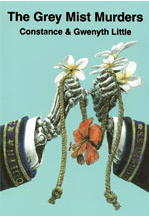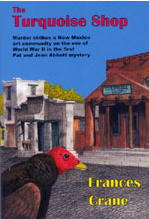|
THE CRIME OF MY LIFE by Marv Lachman
Mysteries are popular in Japan, but so far that country has not bid for a Bouchercon, denying me an especially good excuse to visit it. I have met many Japanese fans at conventions, and they unfailingly seem to be very friendly. Yet, in The Wages of Zen (1979; 1985 in U.S.), English diplomat-author James Melville implies that many Japanese hate outsiders, to whom they refer as gaijin, roughly translated as “stupid foreigners.” This book is about murder at a Zen temple near Kobe, one that attracts some rather strange and dysfunctional Occidentals. It is also about drugs, gangsters, and politics, all of which are somewhat confusingly presented, but then neither the Zen philosophy and attraction get a much clearer description. Melville does better with describing the celebration of New Year’s Day in Japan. He also includes a good bit of sex, mostly gratuitous but erotically described. This is the first appearance of Superintendent Tetsuo Otani, destined to be Melville’s series character, but his detective work is not impressive; he doesn’t even solve the murder, which depends on clues unavailable to the reader. He drinks beer while on duty. I might have to report him, but the series is no longer being published.  Cast your 21st century sensibilities aside before reading The Grey Mist Murders (1938) by Constance & Gwenyth Little, now a Rue Morgue Press trade paperback reprint. (The use of the word “gay” is especially dated – see page 36 – and there is virtually non-stop drinking and smoking.) The Littles owe a great deal to Mary Roberts Rinehart and her strong, yet prone to fainting and screaming, heroines. For those “kids” who don’t know the acronym HIBK (Had-I-But-Known), I can best explain by quoting the Littles’ first-person narrator, Carla Bray, as she says before one of three murders, “If I only could have known how many things were going to happen in that short space of time.” Carla is a suspect in the murders, all of which take place on a cruise ship on its last leg, from Tahiti to San Francisco. Her terror and off again-on again shipboard romance become a bit tiresome, but at other times her sense of humor makes her enjoyable as narrator. Yes, there is the “grey mist” she sees before fainting, but “grey mist” is also used by the Littles to describe the weather as well as an apparent ghost. Talk about getting mileage out of your title. The plot is confusing. A diagram of the locations of the various cabins might have helped. I must admit that more than once I felt like Carla when she says on page 70, “I leaned back in my chair and gave up trying to understand it all.” Still, it gets resolved finally, after an exciting confrontation, albeit not by our heroine, and not by many clues that would help the reader to solve it. You won’t believe the killer’s motivation, but if your tastes mirror mine, you’ll have fun reading this book. I wrote a book about the phenomenon of almost every American mystery in the last 25 years having a strong regional component. By implication, earlier mysteries did not. As I was careful to point out, many did, but they were the exceptions. Proving the rule is Frances Crane’s The Turquoise Shop (1941), reprinted in trade paperback in 2004 by Rue Morgue Press. Its strength lies in its regional descriptions of northern New Mexico, the area in which I now live.  Set in “Santa Maria,” a fictionalized Taos, it tells much about the often prickly relationships among three cultures: Mexican, Native American, and Anglo. Crane has her characters openly reflect the attitudes of the time with generalizations about people of different groups, as when one says, “Time means nothing to an Indian.” In addition to Taos being a multi-cultural town, it is also a famous tourist spot and artists’ colony, and Crane captures both aspects of life there. Though world famous, Taos remains in many ways a small town with gossip important, and Crane shows that was true over sixty years ago. This is the first book in the Patrick and Jean Abbott series, one that Crane was to write successfully for 25 years. In fact, Jean Abbott is still Jean Holly, and this book tells of the Abbotts meeting and getting to know each other. One of the best introductions that Tom and Enid Schantz have done tells about the series and, more important, about Crane’s interesting life, including the fact that she was the mother-in-law of Norbert Davis. The Abbotts will inevitably be compared with the other important husband-and-wife detective teams of their time. Don’t expect the sophisticated humor of the Mr. and Mrs. North series, but Jean Holly is a good first-person narrator (though I would have preferred the story told in the third person) through whose eyes to see the New Mexico scene. Only occasionally does she wander into the HIBK woods as when she says, “...some evil influence seemed always at work.” The goings-on are properly mysterious, and the characters eccentric, perhaps too much so. As Patrick says, “The place is crawling with nuts.” For the most part the telling is concise, though occasionally there are scenes, such as Jean’s cooking a pot roast dinner, that don’t add anything to this book as either a mystery or a regional novel. Crane might also have better lost Jean’s obnoxious cat which bites people. The solution is not the result of clues that are especially fair, but it is one of several surprises to be found in this book that has been out of print for over 60 years. Far easier than defining “Malice Domestic” – the type of mystery, not the convention – is just recommending Say It with Poison (1991) by Ann Granger. This is Granger’s first book and also the first about Meredith Mitchell, a prickly British consular official back in England on leave for her goddaughter’s wedding. There is murder and the beginning of Meredith’s relationship with police inspector Alan Markby, one whose course does not run smoothly. Relationships involving family and friends take up an inordinate amount of time with overlong talks. The dialogue is good at times, which is fortunate because the mystery is not very complex. Many of the clues are withheld by Mitchell from Marky, and the solution is by confession (and a long one at that), not detection. Once, murder at a radio station was a fairly popular topic for mysteries, but I do not recall anyone using that background for many years until K.K. Beck’s We Interrupt This Broadcast (1997), a book that received far less attention than it should have. It’s a funny picture of the people who work for a small classical music station in Seattle and tells much of the economics involved in running an AM station. A “normal” person calls it “one of the flakiest places I’ve ever seen.” Almost all of the staff are among life’s losers, but Beck’s form of humor seems appropriate to depict them, and she even manages to make several sympathetic. She’s especially good at capturing the speech patterns of the late 20th century. The murders are not very complex, and the solution disappoints, depending upon coincidence and not helped by a jumbled sentence on page 191. However, I suspect that you’ll have guessed the killer by then and have had a good time reading. As a fan of theatre, I looked forward to Alma H. Bond’s Murder on the Streetcar (iUniverse, 2004; trade paperback), a mystery about murder during a Broadway revival of Tennessee Williams’s A Streetcar Named Desire. Would this, I wondered, be another The Roman Hat Mystery in its complication of intricate plot and theatrical background? The possibility was enough to make me seek this book, though I feared it might have been vanity-published. Dr. Bond (she’s a psychoanalyst) certainly knows the play; her late husband, Rudy Bond, was in the original cast in 1947 and in the 1951 film version. Alas, this book fails both as a mystery and in its depiction of the theatre scene. Trying to make Streetcar, the play, seem more important than it was – and it is very important in the history of the American theatre – Bond says it is the play that made Tennessee Williams famous. He was already famous when it was produced because of The Glass Menagerie. It is not made believable that a 22-year-old with no New York experience would get the part of Stanley Kowalski in a major revival, as happens here. Marlon Brando had had many major roles before he was cast. None of the characters comes remotely alive, and the plot and dialogue is distinctly clichéd; for example, “I think I helped him feel better about himself.” There is an inordinate number of typos, including one I found amusing about a character with “a sense of quilt.” A word, “inscrutinable,” is coined. There are other errors, in addition to those cited above. A reenactment of a murder includes a character who couldn’t be in it. The age of amateur detective Dr. Mary Wells is unclear. At one point it is implied that the book is set forty years after Streetcar first opened, which would make it in 1987. However, later the date of action is given as 2004. Since Wells was supposed to have been 18 when the original Streetcar opened, that would make her 75. As a fellow septuagenarian, I’m glad to see people of my generation as detectives, though I was amused that Wells has a younger police detective as a lover, which is how she gets involved in the case. While I could accept Inspector Queen bringing Ellery along, somehow I don’t think that in 2004 Lt. John Franklin could get away with bringing an amateur sleuth along. Add many coincidences and an unsatisfactory solution, and you have disappointment. Déjà View Barely known to most American movie viewers is Arthur Wontner who played Sherlock Holmes in five British films in the 1930s, the last of which was SILVER BLAZE (1937), released in the U.S. in 1941 as MURDER AT THE BASKERVILLES, and recently seen on TCM. This film is an expanded version of the famous Holmes story about a race horse, but, somewhat deceptively, there is the titular reference to THE HOUND OF THE BASKERVILLES, released in 1940 as a film with Basil Rathbone. Some of the action takes place at the Baskerville estate, but there is no murder there. Also, while the bones of the “Silver Blaze” plot is used, it is fleshed out to include a horse racing scene. This film is very talky with little atmosphere. Wontner is good as Holmes and Lyn Harding even better as Professor Moriarty. Arthur Goulet, as Colonel Moran, is a dead ringer for John Dickson Carr. As Dr. Watson we have Ian Fleming, not the creator of James Bond, but a British character actor. _____________________________________ YOUR COMMENTS ARE WELCOME. stevelewis62 (at) cox.net This column previously appeared in Mystery*File 46, November 2004. Copyright © 2004 by Steve Lewis. All rights reserved to contributors.
Return to
the Main Page.
|